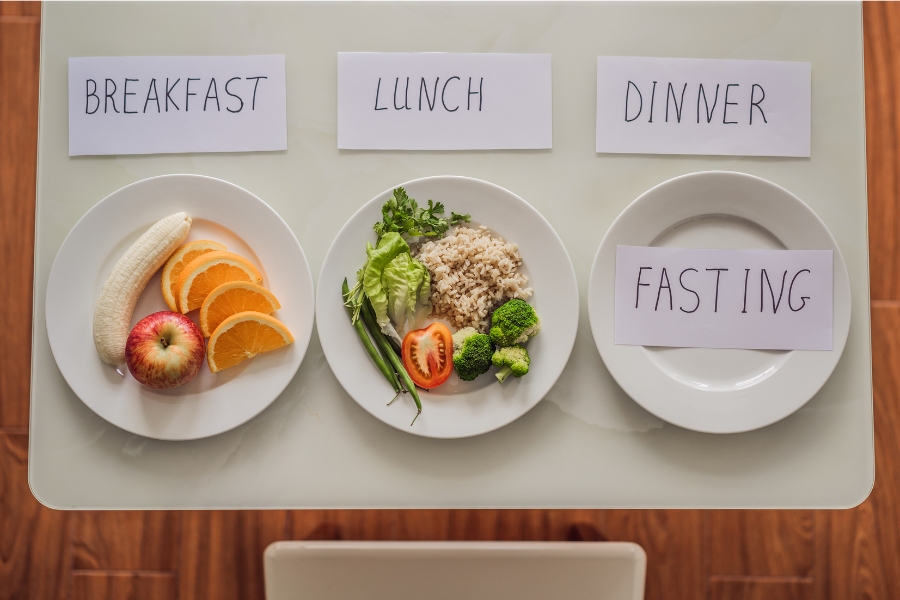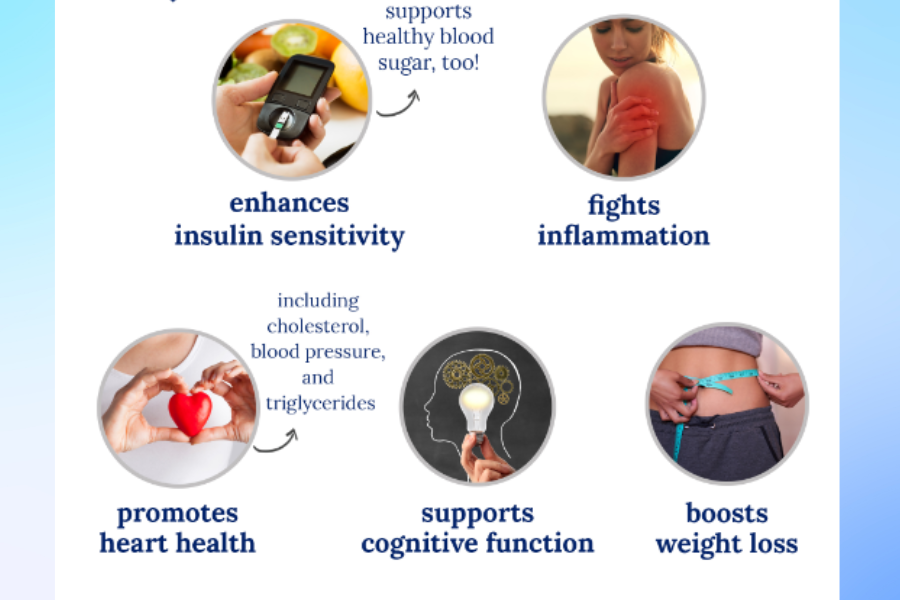Table of Contents
ToggleUnderstanding intermittent fasting for beginners
Intermittent fasting (IF) has become increasingly popular as a lifestyle choice for those seeking health benefits, weight management, and a better relationship with food. For beginners, however, the concept might seem overwhelming. This guide breaks down the basics, helping you understand intermittent fasting and how to get started safely and effectively.

What is Intermittent Fasting?
Intermittent fasting is not a diet, but rather a meal timing pattern. It involves cycling between periods of eating and fasting, allowing your body to burn fat for energy when it’s not being fueled by food. IF focuses on when you eat rather than what you eat.
Popular Methods of Intermittent Fasting
- 16/8 Method (Leangains Protocol):
- This is one of the most common forms of intermittent fasting. You fast for 16 hours and eat within an 8-hour window. Many people find this method easy to follow because the fasting period includes the time when you’re asleep.
- Example: Eat between 12:00 PM and 8:00 PM, then fast from 8:00 PM to 12:00 PM the next day.
- 5:2 Method (Fast Diet):
- In this method, you eat normally for five days of the week, then restrict your calorie intake to about 500-600 calories on the remaining two days.
- Example: Regular eating Monday to Friday, then consuming reduced calories on Saturday and Sunday.
- Eat-Stop-Eat:
- This method involves fasting for a full 24 hours once or twice a week. For example, you might eat dinner at 7:00 PM one day and then fast until 7:00 PM the next day.
- Alternate-Day Fasting:
- As the name suggests, you alternate between days of regular eating and fasting. On fasting days, some people choose to consume a very low-calorie meal (about 500 calories), while others opt for complete fasting.
Benefits of Intermittent Fasting
- Weight Loss and Fat Burning:
- Fasting allows the body to use stored fat for energy, helping you lose weight over time. When you’re not constantly eating, insulin levels drop, which facilitates fat burning.
- Improved Metabolic Health:
- Fasting may improve insulin sensitivity, which can be helpful for preventing or managing conditions like type 2 diabetes.
- Cellular Repair and Autophagy:
- During fasting, the body undergoes cellular repair processes. Autophagy, a process where cells remove damaged components, can improve overall health and prevent disease.
- Mental Clarity and Focus:
- Some people experience enhanced mental clarity and concentration while fasting. This is believed to be due to the increase in norepinephrine and other hormones that support brain function.
- Heart Health:
- Fasting has been shown to improve risk factors for heart disease, such as cholesterol levels, blood pressure, and inflammation.

How to Get Started with Intermittent Fasting
- Choose a Method That Suits You:
- As a beginner, the 16/8 method is usually the easiest to start with. It allows you to fast overnight and skip breakfast, which many people find manageable.
- Stay Hydrated:
- During fasting, it’s important to drink plenty of water, herbal teas, or black coffee to stay hydrated and help suppress hunger.
- Eat Nutrient-Dense Foods:
- During your eating window, focus on nutrient-rich whole foods like vegetables, lean proteins, whole grains, and healthy fats. Avoid bingeing on unhealthy foods, as this can negate the benefits of fasting.
- Listen to Your Body:
- Pay attention to how your body feels. If you feel dizzy, overly fatigued, or unwell, it’s okay to adjust your approach or stop fasting. Fasting isn’t for everyone, and it’s important to find what works for you.
- Ease into It:
- If fasting for 16 hours seems daunting, start with shorter fasting periods and gradually extend them as your body adapts.
Common Challenges and How to Overcome Them
- Hunger Pangs:
- Hunger is common when you first start fasting. It usually subsides after a few days as your body adjusts. Drinking water or herbal tea can help.
- Social Events:
- Fasting can be challenging during social occasions. It’s okay to be flexible with your schedule, adjusting your fasting times when necessary.
- Energy Dips:
- Some people experience lower energy levels at the beginning of their fasting journey. Over time, your body will become more efficient at using stored fat for energy.
Who Should Avoid Intermittent Fasting?
Intermittent fasting may not be suitable for everyone. If you have a history of eating disorders, are pregnant, breastfeeding, or have specific medical conditions like diabetes, it’s important to consult with a healthcare professional before starting intermittent fasting.
Intermittent fasting is a flexible and customizable eating pattern that can offer numerous health benefits, including weight loss, improved metabolic health, and mental clarity. The key is to find a method that works for your lifestyle and listen to your body throughout the process. Start slow, stay hydrated, and focus on nourishing your body during your eating windows.
Benefits of intermittent fasting for beginners
If you’re considering intermittent fasting as a beginner, you’re likely curious about its potential benefits. Intermittent fasting (IF) has gained widespread popularity for its simplicity and potential to improve both physical and mental health. Here’s a breakdown of the key benefits of intermittent fasting for beginners:

Benefits of intermittent fasting for beginners
1. Weight Loss and Fat Reduction
One of the most appealing aspects of intermittent fasting is its potential for weight loss. By restricting the time during which you eat, IF helps reduce overall calorie intake, which can lead to weight loss. Fasting increases the body’s reliance on stored fat for energy, helping you burn more fat, especially in those hard-to-lose areas like belly fat.
For beginners, IF is often easier to stick to than traditional calorie-restricted diets because it doesn’t require tracking every calorie or cutting out specific foods. Instead, you focus on when you eat, not what you eat.
2. Improved Insulin Sensitivity
Intermittent fasting has been shown to improve insulin sensitivity, which is beneficial for regulating blood sugar levels. This can be particularly important for individuals who are at risk of developing type 2 diabetes. As insulin sensitivity increases, your body becomes more efficient at using glucose for energy, reducing blood sugar spikes after meals.
For beginners, this benefit can translate to more stable energy levels throughout the day, fewer sugar cravings, and reduced risk of long-term health issues.
3. Boosted Metabolism
Fasting periods may help to increase your metabolic rate by releasing norepinephrine, a hormone that helps break down fat cells. Additionally, the alternate cycle of fasting and feeding can help maintain lean muscle mass, which is important for keeping your metabolism high.
4. Simplified Eating Patterns
For many beginners, one of the major perks of intermittent fasting is the simplicity it brings to their eating routine. Instead of planning and preparing several meals a day, you can focus on just one or two. This simplification can reduce stress and make it easier to manage busy schedules.
Intermittent fasting frees up mental energy that might have otherwise gone into meal planning, allowing you to focus on other areas of your life.
5. Enhanced Cellular Repair and Longevity
Fasting triggers a process called autophagy, in which the body cleans out damaged cells and regenerates new ones. This process can help protect against diseases like cancer and Alzheimer’s. It also promotes longevity by improving cellular health.
For beginners, knowing that intermittent fasting may contribute to long-term health can serve as powerful motivation.
6. Improved Mental Clarity and Focus
Many people report better mental clarity and focus during their fasting windows. Fasting can help balance brain function by reducing oxidative stress and inflammation. In addition, your brain thrives on ketones, which are produced when your body starts to burn fat.
If you’re new to intermittent fasting, this cognitive boost may help improve productivity and focus, especially during your fasting hours.
7. Better Heart Health
Intermittent fasting may help reduce risk factors for heart disease, such as high cholesterol levels, blood pressure, and inflammation. Some studies suggest that fasting can improve overall cardiovascular health by improving blood lipid profiles and reducing inflammatory markers in the body.
For beginners, adopting a healthier eating pattern through fasting could contribute to better heart health in the long term.
8. Increased Growth Hormone Secretion
Fasting can stimulate the secretion of growth hormone, which is essential for muscle growth, fat loss, and overall body repair. Increased growth hormone levels can help you recover more quickly from workouts, build muscle, and maintain a lean physique.
9. Balanced Hormones
IF can help regulate hunger hormones like ghrelin and leptin. Ghrelin signals hunger, while leptin signals satiety. By improving the balance between these hormones, intermittent fasting can help control your appetite and prevent overeating, making it easier to stick to a healthier diet.
10. Better Digestion
For beginners, one often-overlooked benefit of intermittent fasting is improved digestion. Constantly eating can overload your digestive system, but fasting gives your body time to properly digest and absorb nutrients. It can also alleviate bloating, reduce inflammation in the gut, and lead to better overall digestive health.
Tips for Beginners:
- Start Slow: Begin with a 12-hour fasting window and gradually increase it as your body adjusts.
- Stay Hydrated: Drink plenty of water, tea, or black coffee to stay hydrated during your fasting period.
- Listen to Your Body: Pay attention to hunger signals and don’t force fasting if it feels uncomfortable.
In conclusion, intermittent fasting offers a range of benefits, from weight loss and improved metabolism to better mental focus and cellular repair. For beginners, it provides a flexible, effective way to improve overall health without the complexity of restrictive dieting.
Types of intermittent fasting methods for beginners
Intermittent fasting (IF) has gained popularity as a simple and effective method for weight management, improving metabolism, and promoting overall health. For beginners, it’s essential to choose a method that fits your lifestyle and energy levels. Here are some of the most popular intermittent fasting methods that are beginner-friendly:

Intermittent fasting method for beginners
1. The 16/8 Method (Leangains Protocol)
- How it works: Fast for 16 hours and eat during an 8-hour window.
- Best for: Beginners who want a simple and manageable fasting plan.
- Example: Skip breakfast and eat between 12 PM and 8 PM.
- Benefits: Easy to follow, can help with weight loss, improves insulin sensitivity.
- Tips: Drink water, black coffee, or tea during the fasting period to stay hydrated and curb hunger.
2. The 12/12 Method
- How it works: Fast for 12 hours and eat during a 12-hour window.
- Best for: Complete beginners or those easing into intermittent fasting.
- Example: Eat from 7 AM to 7 PM, then fast overnight.
- Benefits: Very manageable, promotes healthy eating habits, helps regulate blood sugar levels.
- Tips: Gradually increase the fasting window as you get comfortable.
3. The 5:2 Diet (Fast Diet)
- How it works: Eat normally for 5 days a week, and reduce calorie intake to around 500-600 calories on the other two days.
- Best for: People who want flexibility in their weekly routine.
- Example: Eat normally from Monday to Friday, and restrict calories on Saturday and Sunday.
- Benefits: Encourages calorie restriction without full fasting, improves metabolic health.
- Tips: Choose low-calorie but nutrient-dense foods (like vegetables and lean proteins) on fasting days.
4. Eat-Stop-Eat Method
- How it works: Fast for 24 hours once or twice a week.
- Best for: Those looking for a more intense fasting method.
- Example: Fast from dinner one day until dinner the next day.
- Benefits: Powerful for fat loss, improves metabolic rate.
- Tips: Start with a shorter fast (12-16 hours) and build up to a full 24 hours.
5. Alternate-Day Fasting
- How it works: Alternate between fasting days and regular eating days.
- Best for: People looking for rapid weight loss or those with experience in fasting.
- Example: Eat normally on Monday, fast on Tuesday, eat on Wednesday, fast on Thursday, and so on.
- Benefits: Significant fat burning, improves heart health.
- Tips: During fasting days, allow for small meals (around 500 calories) if full fasting is too difficult.
6. The Warrior Diet
- How it works: Eat small amounts of raw fruits and vegetables during the day and have one large meal at night.
- Best for: People who prefer to eat less during the day and enjoy a bigger dinner.
- Example: Fast all day and have one big meal around 7 PM.
- Benefits: May help with weight management, can improve mental clarity during the day.
- Tips: Focus on nutrient-dense foods and avoid overeating during the large meal.
7. Spontaneous Meal Skipping
- How it works: Skip meals whenever it feels convenient.
- Best for: People who prefer a more relaxed, flexible approach to fasting.
- Example: Skip lunch if you’re not hungry, and eat at the next mealtime.
- Benefits: Helps you listen to your body’s natural hunger cues, can lead to moderate calorie restriction.
- Tips: Avoid overeating during the next meal after skipping one.
Tips for Beginners:
- Stay Hydrated: Drink plenty of water, tea, or black coffee during fasting periods.
- Start Slow: Begin with a shorter fasting period, such as 12 hours, and gradually increase it.
- Listen to Your Body: If you feel dizzy, weak, or unwell, adjust your fasting schedule.
- Be Consistent: Stick to a fasting method that fits your lifestyle to see long-term benefits.
Intermittent fasting can be highly effective, but it’s important to choose a method that works with your lifestyle and health needs. As with any dietary changes, it’s always good to consult a healthcare professional, especially if you have any underlying health conditions.
A step-by-step guide to intermittent fasting for beginners
Intermittent fasting (IF) is a powerful tool for weight loss, improved health, and longevity. For beginners, the concept can feel daunting, but it’s actually simpler than most diets. The key is controlling when you eat rather than what you eat. Below is a step-by-step guide to help you ease into intermittent fasting and make it part of your lifestyle.

A step-by-step guide to intermittent fasting for beginners
Step 1: Understand What Intermittent Fasting Is
Intermittent fasting is not about restricting calories but about creating a specific eating window. There are several popular methods, including:
- 16/8 Method: Fast for 16 hours and eat within an 8-hour window.
- 5:2 Method: Eat normally for five days and limit calorie intake to 500-600 on two days.
- Eat-Stop-Eat: Fast for 24 hours once or twice a week.
As a beginner, the 16/8 method is generally the easiest and most sustainable to start with.
Step 2: Choose Your Eating Window
Once you’ve chosen your fasting method, pick an eating window that fits your lifestyle. For instance, if you prefer to skip breakfast, you can eat from 12 PM to 8 PM (16/8 method). If you’re more of a morning person, you might eat from 9 AM to 5 PM. The goal is to find a time that doesn’t interfere with your daily routine.
Step 3: Start Slow and Gradual
Don’t jump into a full 16-hour fast on day one. Start with a 12-hour fast and a 12-hour eating window (e.g., 7 AM to 7 PM). Once you feel comfortable, increase your fasting period to 14 hours, then finally 16 hours. This gradual approach helps your body adapt and reduces the chance of overwhelming hunger.
Step 4: Stay Hydrated
During your fasting period, it’s crucial to drink plenty of water. You can also enjoy calorie-free drinks like black coffee, tea, or sparkling water. Staying hydrated helps reduce hunger pangs and keeps you energized.
Step 5: Focus on Nutrient-Dense Foods
While intermittent fasting doesn’t dictate what you should eat, it’s important to fill your eating window with nutrient-dense foods. Focus on:
- Lean proteins: Chicken, fish, eggs, tofu
- Healthy fats: Avocados, nuts, olive oil
- Complex carbs: Whole grains, sweet potatoes, quinoa
- Vegetables: Spinach, broccoli, kale
- Fruits: Berries, apples, oranges
Eating balanced meals ensures you get the nutrients you need to stay full and satisfied during your fasting window.
Step 6: Listen to Your Body
At first, you may feel hungry or experience fatigue while adjusting to intermittent fasting. Listen to your body and don’t push yourself too hard. If you feel dizzy or overly tired, eat something nutritious and try again the next day. Intermittent fasting is flexible—adapt it to your body’s needs.
Step 7: Exercise During Fasting
If you’re used to working out, you can continue exercising while fasting. Many people find that working out in a fasted state enhances fat burning. Start with low to moderate-intensity workouts like walking, yoga, or light strength training, and see how your body responds.
Step 8: Break Your Fast Mindfully
When it’s time to eat after fasting, avoid the temptation to binge. Start your meal with a balance of protein, healthy fats, and fiber to stabilize blood sugar levels. Breaking your fast with a large meal or processed foods can lead to spikes in blood sugar and fatigue.
Step 9: Be Consistent
Like any lifestyle change, consistency is key. Stick with your chosen method of intermittent fasting for at least 4-6 weeks to allow your body to adjust and see results. Keep track of how you feel, your energy levels, and any progress toward your health goals.
Step 10: Adjust As Needed
Intermittent fasting should enhance your life, not cause stress or discomfort. If you find the fasting method too rigid or challenging, don’t hesitate to make adjustments. Whether that means changing your eating window or fasting fewer days a week, customize it to fit your needs.
Tips for Success:
- Stay busy during fasting hours – This helps keep your mind off food.
- Drink water often – Hydration is key to curbing hunger.
- Get enough sleep – Rest supports your fasting efforts and overall health.
- Set small goals – Celebrate the small wins to stay motivated.
- Pair IF with healthy habits – Focus on nutrition, exercise, and stress management.
Intermittent fasting is a flexible and effective way to improve your health, manage weight, and gain mental clarity. Start slow, be patient with your body, and find the approach that works best for you. With time, it will become a natural part of your routine, and you’ll reap the benefits of this powerful eating pattern.
Tips for a successful beginner’s intermittent fasting journey

Intermittent fasting method for beginners
Here are some practical tips for a successful beginner’s intermittent fasting journey, designed to help you ease into the process and achieve your health goals:
1. Choose the Right Fasting Method
Intermittent fasting has several methods, such as the 16/8 method (fast for 16 hours and eat during an 8-hour window), 5:2 method (eat normally for 5 days and restrict calories for 2 days), or alternate-day fasting. As a beginner, start with a more manageable option like the 16/8 method. This allows your body to adjust while giving you the flexibility to experiment with eating windows that fit your schedule.
2. Ease Into It Gradually
Don’t jump straight into long fasting hours. Begin by shortening your eating window by a couple of hours and gradually increase your fasting time. This gentle approach allows your body to adapt to the changes without causing unnecessary stress or discomfort.
3. Stay Hydrated
During your fasting periods, drink plenty of water to stay hydrated. Water, herbal teas, and black coffee are excellent options. Staying hydrated will also help you manage hunger pangs and maintain energy levels throughout the day.
4. Focus on Balanced Nutrition During Eating Windows
The meals you consume during your eating windows are crucial. Focus on whole, unprocessed foods that are rich in protein, healthy fats, and fiber. These foods will keep you full for longer and provide essential nutrients to fuel your body. Avoid sugary or highly processed foods, as they can cause energy crashes and trigger more hunger.
5. Listen to Your Body
It’s essential to pay attention to how your body responds to fasting. If you feel lightheaded, excessively fatigued, or irritable, it might be a sign to adjust your fasting window or incorporate more nutritious foods into your meals. Fasting should not feel like torture—it should empower you.
6. Get Enough Sleep
Quality sleep is essential for regulating hunger hormones and improving your overall well-being. Lack of sleep can make fasting more difficult, as it often triggers hunger and cravings for unhealthy foods. Aim for 7-9 hours of restful sleep each night to support your fasting journey.
7. Exercise Smartly
Light to moderate exercise, such as walking, yoga, or strength training, can complement your intermittent fasting routine. However, avoid intense workouts during long fasting periods, especially as a beginner. Instead, schedule workouts during your eating window when you have more energy.
8. Stay Consistent
Consistency is key to reaping the benefits of intermittent fasting. Stick to your chosen schedule for at least a few weeks before evaluating its impact. The first few days may be challenging as your body adjusts, but over time, fasting will become more natural and easier to follow.
9. Manage Hunger with Distractions
During fasting periods, hunger can be a challenge, especially when you’re just starting out. Distract yourself with activities like reading, working, or taking a walk. Often, hunger is psychological, and staying busy can help you overcome it without giving in to cravings.
10. Be Patient and Flexible
Intermittent fasting is not a one-size-fits-all approach. If one method doesn’t work for you, feel free to experiment with others. The key is to find a routine that fits into your lifestyle and aligns with your health goals. Be patient with yourself, and don’t expect instant results—sustainable progress takes time.
11. Seek Professional Advice
If you have any pre-existing health conditions or are taking medications, it’s important to consult a healthcare provider before starting intermittent fasting. They can guide you on the best approach for your individual needs and ensure that fasting is a safe practice for you.
12. Track Your Progress
Keep a journal to monitor how you feel during fasting periods, how your energy levels fluctuate, and any changes in your mood or physical appearance. Tracking your progress will help you stay motivated and adjust your fasting strategy if needed.
Starting your intermittent fasting journey requires patience, self-awareness, and consistency. By following these tips, you’ll not only help your body adjust more easily but also set yourself up for long-term success. Stick to the basics, be flexible, and, most importantly, listen to your body’s needs along the way.
Common mistakes to avoid when starting intermittent fasting
Intermittent fasting has gained immense popularity for its potential health benefits, including weight loss, improved metabolism, and increased energy. However, when starting intermittent fasting, many people make common mistakes that can hinder their progress or even lead to negative effects. Here’s a list of mistakes to avoid when beginning your intermittent fasting journey:

Common mistakes to avoid when starting intermittent fasting
1. Not Easing Into It
One of the most common mistakes is jumping into an extreme fasting window right away, such as a 16:8 or 20:4 fasting-to-eating ratio. Starting with long fasting periods can lead to fatigue, irritability, and even binge eating during your eating window. It’s crucial to start with shorter fasting periods (like 12:12) and gradually extend the fasting window as your body adjusts.
2. Overeating During the Eating Window
Many people mistakenly think that they can eat anything they want during their eating window. Overeating or consuming calorie-dense, unhealthy foods can negate the benefits of intermittent fasting. Focusing on nutrient-rich foods like lean proteins, healthy fats, vegetables, and whole grains will provide your body with the fuel it needs and support weight loss and energy levels.
3. Underestimating Hydration
Fasting can sometimes lead to dehydration if you’re not drinking enough water throughout the day. You should consume plenty of water during both your fasting and eating windows to avoid symptoms like headaches, dizziness, and fatigue. Some people also find that drinking herbal teas or black coffee can help curb hunger without breaking the fast.
4. Not Listening to Your Body
It’s easy to ignore your body’s signals when following strict fasting schedules. However, intermittent fasting is not one-size-fits-all, and if you experience extreme hunger, fatigue, or other negative symptoms, it may be a sign that you need to adjust your fasting window or consult with a healthcare professional. It’s important to listen to your body and make changes as needed.
5. Being Too Rigid
Flexibility is key when starting intermittent fasting. Many people make the mistake of sticking too rigidly to their fasting schedule even when it doesn’t suit their lifestyle. For example, if a social event or special occasion occurs, it’s okay to adjust your fasting window accordingly. Avoid feeling guilty or stressed if you need to alter your plan for a day.
6. Ignoring Nutritional Needs
Fasting doesn’t mean neglecting your body’s nutritional needs. Many beginners focus solely on the fasting period and forget to prioritize balanced meals during their eating window. It’s essential to ensure you get enough vitamins, minerals, proteins, and healthy fats to keep your body functioning optimally. Malnutrition can lead to decreased energy, mood swings, and even muscle loss.
7. Expecting Instant Results
Intermittent fasting is not a quick fix. A common mistake is expecting immediate weight loss or other health benefits. Sustainable results take time, and intermittent fasting should be seen as a long-term lifestyle change rather than a short-term diet. Patience and consistency are key to seeing the benefits of this practice.
8. Skipping Fasting on Weekends
For beginners, maintaining consistency is crucial. Some people fast during the weekdays and abandon their fasting routine on weekends, which can disrupt their progress. It’s essential to stay consistent, even during the weekends, to see long-term benefits.
9. Fasting Despite Feeling Unwell
If you’re sick or feeling unwell, fasting can exacerbate your symptoms by depriving your body of energy. In such cases, it’s okay to pause fasting and focus on recovery. Your body needs adequate nutrition and energy to heal, so don’t push through fasting if it feels counterproductive to your health.
10. Not Adjusting for Activity Levels
Your fasting routine should be adjusted based on your physical activity. Fasting on days when you engage in intense physical activity without proper nutrition can lead to low energy levels, dizziness, and muscle loss. On workout days, consider fasting for shorter periods or consuming a nutrient-rich meal after exercising to support recovery.
Intermittent fasting can be a powerful tool for improving your health, but like any lifestyle change, it’s important to avoid common pitfalls. By easing into fasting, eating mindfully, staying hydrated, and being flexible, you’ll increase your chances of success. Always remember to listen to your body, prioritize nutrition, and be patient with the process.
Track your progress and adjust your intermittent fasting routine
Tracking your progress is an essential part of your intermittent fasting journey. Here are some effective ways to track your progress and make necessary adjustments:

Intermittent fasting method for beginners
1. Set Clear Goals
Before diving into the tracking process, establish what you aim to achieve with intermittent fasting. Your goals might include:
- Weight Loss: Aiming for a specific weight or body fat percentage.
- Improved Metabolism: Enhancing metabolic health markers such as blood sugar levels.
- Increased Energy: Boosting overall energy and mental clarity.
- Better Digestion: Addressing digestive issues or improving gut health.
Having clear goals will guide you in selecting the right metrics to track and will help you measure your success.
2. Choose Your Metrics
To track your progress effectively, consider monitoring the following metrics:
- Body Weight: Weigh yourself regularly, but not too frequently, as daily fluctuations are normal. Weekly or bi-weekly weigh-ins are usually sufficient.
- Body Measurements: Track measurements like waist circumference, hip circumference, and body fat percentage to get a fuller picture of your progress.
- Energy Levels: Keep a journal of your daily energy levels, mood, and cognitive function. This can help you identify patterns and adjust your routine if needed.
- Physical Performance: Monitor your performance in workouts or daily physical activities to assess how intermittent fasting affects your strength, endurance, and recovery.
- Health Markers: If you’re using intermittent fasting for health reasons, track relevant health markers such as blood sugar levels, cholesterol, or blood pressure, if applicable.
3. Use a Tracking Tool
Several tools can aid in tracking your intermittent fasting progress:
- Apps: Utilize apps specifically designed for intermittent fasting, such as Zero, Life Fasting Tracker, or Fastient. These apps allow you to log fasting windows, track progress, and set reminders.
- Journals: Maintain a fasting journal where you record your eating windows, physical measurements, mood, and energy levels. This can be as simple as a notebook or a digital document.
- Wearables: Fitness trackers or smartwatches can help monitor physical activity, sleep patterns, and other health metrics that can complement your fasting routine.
4. Evaluate Your Results
Regularly review the data you’ve collected. Look for trends and patterns that indicate how well your intermittent fasting routine is working:
- Weight Trends: Is your weight moving towards your goal? Are there any plateaus or unexpected fluctuations?
- Energy and Mood: Are your energy levels and mood stable? Have you noticed any improvements or declines?
- Physical Performance: Are you seeing enhancements in your workout performance or daily activities?
- Health Markers: Are your health markers improving according to your goals?
5. Adjust Your Routine
Based on your evaluation, you might need to adjust your intermittent fasting routine:
- Modify Fasting Windows: If you’re not seeing the desired results or experiencing fatigue, consider adjusting the length of your fasting and eating windows. For example, if you’re doing a 16:8 schedule, you might switch to a 14:10 or 18:6 schedule.
- Change Eating Patterns: Experiment with different meal timings or types of foods during your eating windows to find what works best for your body.
- Address Physical or Emotional Symptoms: If you’re experiencing negative symptoms like irritability, weakness, or digestive issues, it might be worth consulting with a healthcare professional to tweak your approach.
6. Stay Flexible
Intermittent fasting is not a one-size-fits-all approach. What works for one person may not work for another. Stay flexible and open to adjustments as you learn more about how your body responds. Continuous assessment and adaptation are key to long-term success.
7. Seek Professional Guidance
If you encounter persistent issues or have specific health concerns, consider seeking advice from a nutritionist, dietitian, or healthcare provider. They can offer personalized recommendations based on your health profile and goals.
By diligently tracking your progress and making informed adjustments, you can optimize your intermittent fasting routine to align with your personal health objectives and lifestyle. Keep in mind that consistency and patience are essential as you work towards your goals.
Incorporate exercise and nutrition into your intermittent fasting routine
Incorporating exercise and nutrition into your intermittent fasting routine can significantly enhance the effectiveness of the practice, leading to better overall health, improved energy levels, and sustained weight management. Here’s how to balance these elements while practicing intermittent fasting:

Incorporate exercise and nutrition into your intermittent fasting routine
1. Understand Your Fasting Window and Exercise Timing
Timing your workouts around your fasting window can make a big difference in how your body performs and recovers.
- Morning Workouts (Fast State): Exercising in the morning, before eating, can help maximize fat burning because your body is in a fasted state and more likely to use fat as fuel. This works well for light cardio or low-intensity exercises.
- Post-Fast Workouts (Fed State): If your workout is more intense, like strength training or HIIT, it’s better to perform it right after breaking your fast. This is when your body will have readily available nutrients from your meal to fuel muscle recovery and performance.
2. Choose the Right Types of Exercise
Not all exercises are equal when fasting. Your workout should match your fasting schedule and energy levels.
- Strength Training: Great for building muscle and toning. If you do strength training during fasting, opt for shorter sessions, and always prioritize good form over lifting heavier weights.
- Cardio: Low-intensity cardio such as walking, jogging, or cycling can be done during the fasting window since it doesn’t require as much energy from immediate carbohydrate sources.
- High-Intensity Interval Training (HIIT): HIIT can be challenging while fasting, so it’s best to schedule these workouts after breaking your fast or in the eating window. You’ll need fuel to keep your energy high and avoid muscle breakdown.
3. Plan Your Nutrition Around Your Workouts
Your nutrition should support both your fasting goals and your exercise routine. Focus on nutrient-dense foods that provide sustained energy, aid in muscle recovery, and optimize overall health.
- Pre-Workout Nutrition: If you’re eating before a workout, aim for a balanced meal with carbs, protein, and healthy fats. For example, a banana with peanut butter or a small bowl of oatmeal with berries provides the necessary carbs to fuel your exercise and the protein to support muscle recovery.
- Post-Workout Nutrition: After a workout, especially if you’ve done strength training, it’s important to consume protein and carbohydrates. Protein shakes, eggs, grilled chicken, or fish with a side of sweet potatoes or quinoa can replenish glycogen and repair muscles.
4. Stay Hydrated
Hydration is critical, especially when fasting, as your body can easily become dehydrated. Drinking water, herbal teas, and electrolytes can help sustain energy levels and support your workouts.
- During Fasting: Keep drinking water throughout the fasting window to avoid dehydration, especially if you work out during this period.
- Post-Workout: A glass of water with a pinch of salt or an electrolyte drink can help replace lost minerals after a workout, particularly if you’ve been sweating.
5. Supplement Wisely
Intermittent fasting, combined with exercise, may increase the need for certain nutrients to help with muscle recovery and overall health.
- BCAAs (Branched-Chain Amino Acids): These can be taken during your fasted workout to help prevent muscle loss while training in a fasted state.
- Magnesium and Potassium: These electrolytes are important for muscle function and may be depleted during fasting or exercise.
- Protein: If you find it challenging to meet your protein needs through food alone, supplementing with a high-quality protein powder can support muscle repair and growth.
6. Listen to Your Body
Intermittent fasting and exercise can be a powerful combination, but it’s important to listen to your body and adjust as needed. If you feel fatigued or weak during your workouts, it may indicate that you need to adjust your eating window, increase your nutrient intake, or choose lighter exercises.
By integrating smart exercise strategies and optimal nutrition into your intermittent fasting routine, you can maximize the benefits of both practices, leading to improved fitness, better body composition, and enhanced overall well-being.
Frequently asked questions about intermittent fasting for beginners
- Can I drink coffee or tea while fasting? Yes, black coffee and herbal tea are allowed during fasting because they do not contain any calories.
- Does intermittent fasting slow down my metabolism? No, intermittent fasting will not affect your metabolism. In fact, it can boost your metabolism by increasing fat burning and maintaining muscle mass.
- Can I take supplements while fasting? Several supplements can be used during fasting periods, but it’s best to consult with a healthcare professional to determine which is right for you.
- Can I still socialize and eat out while intermittent fasting? Yes, intermittent fasting can be flexible, allowing you to enjoy social events and eating out. Choose wisely and plan your meals accordingly.
- Is intermittent fasting safe for everyone? Although intermittent fasting is generally safe for most people, it may not be suitable for people with certain medical conditions. It’s best to consult a healthcare professional before starting intermittent fasting.
Conclusion: Harness the power of intermittent fasting
Intermittent fasting is a powerful tool that can transform your health and well-being. By understanding the different methods, setting goals, and following step-by-step instructions, you can begin your journey to successful intermittent fasting. Remember to stay consistent, listen to your body and adjust as needed. With patience and persistence, you can unleash the power of intermittent fasting and achieve your health and fitness goals.
Are you ready to unleash the power of intermittent fasting? Start your journey today and experience the transformative benefits it has to offer.
















[…] intermittent fasting can provide numerous benefits on its own, incorporating certain supplements into your routine can […]
[…] people naturally fast during their sleep, intentional fasting periods extend beyond nighttime rest. The most embraced intermittent fasting methods […]